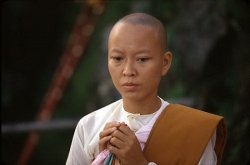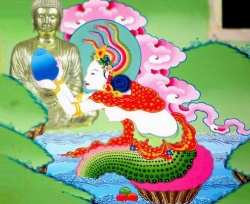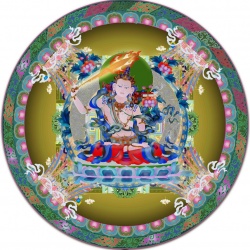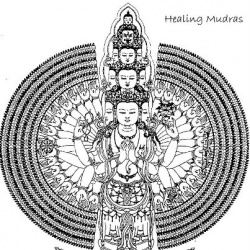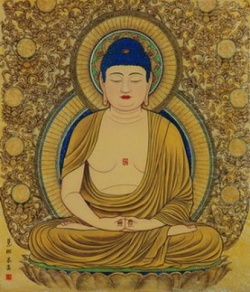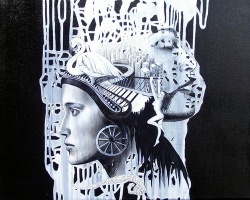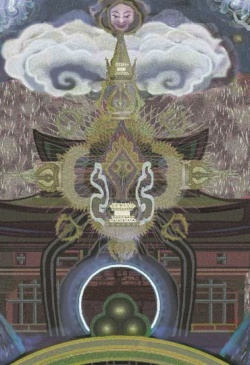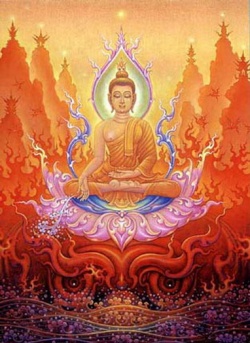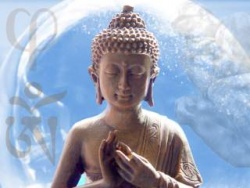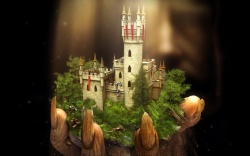Historical References
The Fifth Dalai Lama
Folio 157 (front and back) of the autobiography of the Fifth Dalai Lama (1617-1682) called Dukulai Gosang, Volume Kha, Lhasa Publication:
It is well known that at Dhol Chumig Karmo[1] a very powerful perfidious interfering spirit (dam sri)[2,] born due to distorted prayers, has been harming the teaching of the Buddha and sentient beings in general and in particular. The harmful activity has intensified since the firebird year (1657) and (the spirit) has been successful in many of his missions. However, hardly anyone has taken any action, as if this did not concern him or her. So, at the end of the earth-bird year (1669) a new house was constructed at Dhol Chumig Karmo and articles were placed there in the hope that it would become a place for the Gyalpo to settle. However, his harmful activities only intensified and recently many lay and ordained people have been afflicted with diseases and a few monks have died. Therefore, all the monks unanimously decided that a fire ritual should be performed.
Consequently, two groups of practitioners were organised. One was led by Nagrampa Dhondup Gyatso, who acted as the Vajra Acharya of (a performance of) the Dorje Drolo ritual and the other was led by Nangjung Ngagchang Losang Khyentse, who acted as the Vajra Acharya of (a performance of the) Yangsang Karma Dragpo ritual. Likewise Rigzin Pema Thinley of Dorje Drag, Dharma King Terdag Lingpa, Vugja Lungpa, Drigung Tulku Rinpoche, ]]Katshal Zurpa Ngari Konchok Lhundup]] and Palri Tulku performed the Wrathful Lama, Yama, Phurba, Loktri practice for seven days, at the conclusion of which a fire-ritual was performed during which the 'perfidious interfering spirit’ and his entourage were burnt. Everybody was convinced (of its success because of) the appearance of wonderful signs and the smell of burning flesh that everybody witnessed. Thus, many sentient beings were explicitly granted the gift of fearlessness because their lives were saved. Moreover, indirectly these creatures (‘byung po)[3] were delivered to the peaceful state of being released from having to experience the intolerable suffering of bad states of rebirth due to their increasing negative actions.
At that time a testimony[4] was written to indicate that these creatures or evil spirits were without protection and refuge and (consequently) the Dardhingpas of Dorje Drag Monastery compiled mantras. As a religious practice for the deceased, Sera and Drepung Monasteries performed the Prayer of the White Umbrella Deity 44,000 times and recited the Heart Sutra 118,000 times during eleven sessions during which tea was offered in each monastery.
At sixty-seven other well-disciplined monasteries in the neighbourhood, monks were requested to perform the White Umbrella Prayer as many as possible for the deceased. At Yerpa the Gyuto monks performed the prayer of appeasement of Gonpo (Mahakala) and Choegyal (Dharmaraja) 693 times, Tenma Shasana 1,121,800 times, (Sixty Section Ritual Cake Offering to Overcome Evil) Drugchu pai Tordog. At Choekhor Gyal they performed rituals to (Palden Lhamo) Magzorma, to Mahakala the Lord of the Tent (Gur and zhal), and to Begtse and at Gatshal they performed the prayer of appeasing the Dharma protectors in general 10000 times and the prayers of the Six Armed Mahakala), Leshin and Vaishravana (rNam sre) 1000 times. At 11 district capitals they performed the Prayer for Invoking the Spirit of the Deity to Vanquish the Enemy (dgra-lha-dpangs-bstod) and other practices to appease local deities and spirits.
Notes:
Dhol Chumig Karmo is Shugden’s place of origin, where a shrine was constructed to him. He is also referred as Dholgyal because he is a Gyalpo from Dhol Chumig Karmo. Gyalpo refers to a class of evil spirit. Since Shugden belong to this group, he is also called Gyalchen, the great Gyalpo.
Dam sri, a transgressive interfering spirit, is the spirit of one who has deliberately breached his oath or commitment to his lama out of resentment and dissension.
‘Byung po means creature or evil spirit.
Zur dpang refers to a testimony or the deposition of a witness.
Translation of the testimony that the Fifth Dalai Lama (1617-1682) mentions in his autobiography. The original Tibetan can be found on page 148 front and back (English pages 423 and 424) of the volume Da of his Collected Works published in Gangtok, Sikkim.
"Because of the manipulations of Lag Agyal (the mother) of Gekhasa, the false reincarnation of Tulku Sonam Geleg Palsang (Tulku Dakpa Gyaltsen) got his way (and was installed as the successful candidate). However, because of distorted prayers he became a perfidious spirit (dam sri) and brought serious harm to sentient beings. Therefore, a total of seven groups of practitioners led by (Pema Trinley) Rinpoche of Dorje Drag, Choegyal Terdag Lingpa, Choeje Vugja Lungpa, Ngari Ngagchang Konchok Lhundup, Palri Tulku and two groups of practitioners of Phende Legshe Ling (Namgyal Dratsang) performed a ritual fire offering and burnt the interfering spirit. This is the declaration I have written at that time.
To the deities, Legden, Chagdrug, Leshin and Magzor.
To the oath bound protectors Gongzhi, Gonpo, Chamsre and Begtse, etc.
Who have been propitiated and whose practice (has been done)
I offer this sublime libation.
The so-called Dragpa Gyaltsen pretends to be a sublime being,
Even though he is not,
And since this interfering spirit and creature of distorted prayers
Do not support, protect or give him shelter, but grind him to dust.
To the female protectors like Nodjin Yangghaza, etc. and
Gyalpo Ku-nga, Khyabjug, Dorje Leg and particularly
Nechung and his entourage
I offer this sublime libation.
The so-called Dragpa Gyaltsen pretends to be a sublime being,
Even though he is not,
And since this interfering spirit and creature of distorted prayers
Is harming everything - both the dharma and sentient beings -
Do not support, protect or give him shelter, but grind him to dust.
To the seven Barwa brothers like Tse-marpa etc.
And likewise Setrab of Sangphu etc. - the wrathful gods and spirits
Among whom this negative spirit seeks support -
I offer this sublime libation.
The so-called Dragpa Gyaltsen pretends to be a sublime being,
Even though he is not,
And since this interfering spirit and creature of distorted prayers
Is harming everything - both the dharma and sentient beings -
Do not support, protect or give him shelter, but grind him to dust.
Having agreed before the root and lineage lama Vajra Dharas
To increase what is good and beneficial to sentient beings and the dharma,
If you protect this perfidious spirit,
Will you not cause your own past pledges to degenerate?
There are groups of interfering spirits who display inopportune miracles
In the form of human sickness, cattle disease, hailstorms, famine and drought.
May their power and ability
Their body, speech and mind be smashed into tiny particles.
Trichen Ngawang Chokdhen (1677-1751)
From page 67 of the biography of Trichen Ngawang Chokdhen (1677-1751) composed by Changkya Rolpai Dorje (1717-1786):
Previously, a very vicious and evil spirit (it is not specifically stated that the spirit is Dholgyal, but it is clear from Changkya's biography that the spirit referred to is Dholgyal. It also refers to the time when Trichen Ngawang Chokdhen was the Ganden Throne-holder,) possessed a man at Draksep. Some unstable lamas, former abbots, and monastic hostels (khangtsens) did practice in relation to it simply by invoking and propitiating it. A cairn for invoking spirits had also been erected on top of the Jangtse mountain. Considering how inappropriate was this turn of events he issued an edict to the assembly of monks that as there had been no tradition of propitiating worldly spirits and protectors within the premises of this seat of learning since the time of Je Tsongkhapa, henceforth, nobody would be allowed to engage in such activities. The cairn was demolished (this is very clearly stated in the biography of Changkya) and the stones and earth were returned to the places from which they had been taken. The spirit was invoked through a medium in trance and was then ordered not to come through such trances henceforth. Dolgyal replied, "If this is the order of Tri Rinpoche, I have no choice but to leave." Then, the ghostly spirit fled to Taktse Shol. Je (Trichen Ngawang Chokdhen) himself went into retreat. He made it a rule that the prayer to Dharmaraja composed by the Omniscient Gendun Gyatso (the second Dalai Lama), should be said in the Main Hall of Ganden. Due to Dharmaraja's wrath, the Lamas and former abbots who had been propitiating the spirit were killed and the monastic hostels also suffered many misfortunes. Consequently, such misdeeds entirely ceased and the action that had been taken became an excellent cause for maintaining the purity of the monastery.
Phurchok Ngawang Jampa (1682 – 1762)
In the Catalogue of the Three Monastic Seats composed by Phurchok Ngawang Jampa (1682-1762):
Thus, at the time when Je (Tsongkhapa) himself was alive, apart from those dharma protectors who are bound by oath and are mentioned in the tantras themselves, no objects for propitiating or seeking the slightest help of harmful negative worldly spirits who are ghosts, was ever installed within the premises of this monastic seat. As a result, all the members of the community, both Lamas and disciples lived in harmony and the tradition of study and practice flourished. Even (the cairn) to the spirit of Tsongkhapa's birthplace was placed outside the monastery. However, nowadays, many people who consider themselves to be followers of Tsongkhapa, and who adopt the three robes of a fully ordained Buddhist monk, go for refuge in ghostly spirits. They will have to face the consequence of meeting with great misfortune.
Yongzin Yeshi Gyaltsen (1713 – 1793)
From The Lotus Ornamenting the Teachings of the Buddha. Biography of Yongzin Yeshi Gyaltsen (1713 – 1793); the tutor of H.H Jampel Gyatso, the eighth Dalai Lama. Composed by the Eighth Dalai Lama.
Further, with regard to the education of the young Panchen Rinpoche (name and year), all his attendants should take full care. It would be a great shame otherwise, saying that he is a Buddha and needs no effort as required by an ordinary (child). Even if he is a Buddha, as long as he assumes an ordinary aspect, he should be given the education the way it is given to an ordinary person. It would be an incomplete legacy pertaining to service of the Dharma and sentient beings; the ones left by unlearned scholars and untrained yogis. Therefore, everyone should take utmost care about the study of the venerable (Panchen Rinpoche).
Another point to be considered is that the new Dharma protector (Dolgyal) is the source of ruin of Tashi Lhunpo (monastery). The very Dharma protector, which Panchen Losang Choegyan is connected with, will suffice. Other than that, if (the monastery) starts introducing the propitiation of some harmful spirit, it will be a great source of inauspiciousness (to the monastery). Everyone should be extremely cautious about it.
Thukan Lobsang Choekyi Nyima (1737–1802)
On page 446 of volume Ka, Zhol edition, of the Collected Works of the great Gelugpa scholar, Thukan Lobsang Choekyi Nyima (1737–1802) , which was reprinted in 1969 in New Delhi, the following account is found of (a conversation between) Changkya Rolpai Dorje (1717–1786) and his student Thukan Lobsang Choekyi Nyima:
Reaching the site of the cairn to Machen, he explains in detail to Thukan Lobsang Choekyi Nyima as follows: "Je Lama (Tsongkhapa) and his students do not propitiate worldly gods and protectors and hence even the cairn of Machen, the god of his birthplace, is not included within the parameter of the circumambulatory (path at Ganden). (However,) in the past some Ganden Throne Holders propitiated Dolgyal (Shugden) and experienced misfortunes, consequently Tri Chen Dorje Chang dismantled Dolgyal's image and shrine and banished it from the monastery.”
Phabongkhapa Dechen Nyingpo (1878–1941)
On pages 471-2 front and back of the Tibetan text of the biography of Phabongkhapa Dechen Nyingpo (1878-1941) composed by his student Denma Losang Dorje and published by the Nyimo Publisher Palden, the following account is found:
"(Here is) an appeal from me, Phabongkhapa, holding the name of an incarnate, in accordance with an instruction that I have received from you through Tse Khendron Chenmo. (I am glad that) you have received my application of 22nd of the 12th month last year, and I am grateful that you have kindly clarified each and every point therein. It was entirely my mistake and I have absolutely nothing to say (to defend it). It will be my endeavour in the future to take the meaning of your instructions earnestly to heart and I ask your forgiveness for whatever mistakes I have made in my appeal."
Phabongkhapa quotes the Dalai Lama's letter: "With regard to the three points mentioned here, there is still much ground for debate, both in logical and scriptural terms, but this is enough for the time being. With regard to your reference to making endeavour in the practice of taking refuge, first of all you are propitiating Shugden (Dolgyal) as a protector. Since they received Lamrim teachings from you at the Drepung Monastic Religious Centre last year and so made a connection with you, propitiation of Shugden among students there has greatly increased. The Great Nechung Choegyal who from the very beginning was commanded and entrusted to protect and guard this monastery, expressed his displeasure to the Drepung Lachi several times, saying that (due to propitiating Dolgyal) the degeneration of the Buddha dharma had been speeded up. This is the source of his displeasure. I feel that your seeking the support of a wrathful worldly spirit (to secure benefits in) this life specifically contradicts the precepts of taking refuge. Therefore, your statement, ‘I want to say from the depths of my heart that it is only due to my being confused by ignorance and not that I have knowingly entered an unwholesome path and led others onto the same path.’ is contradictory."
Phabongkhapa answers: "You have therefore instructed me to give you an answer. I have propitiated Shugden until now because my old mother told me that Shugden is the deity of my maternal lineage. I wish to inform you that henceforth, with intense regret (for what is past) and (with the intention of) restraining my faults (in the future), I will never again propitiate (Shugden) or make daily offerings and supporting prayers and that I will wholeheartedly keep this commitment in the core of my heart. Whatever mistakes I have committed until now, such as having become a cause for the mental displeasure of the Great Nechung Choegyal, contradicting the precepts of taking refuge and so forth, I request you, the supreme protector, who is especially compassionate to the lowly, to regard me with love and great compassion and patiently to forgive me.
With great respect I here offer one silk scarf as a medium of request and five silver coins (to contribute to the) mandala offering.
Jigme Dhamchoe Gyatso (1898–1947)
The following account is found on pages 394 and 395 of the Biography of Jigme Dhamchoe Gyatsho (1898–1947) by the Dhomey scholar Tsetan Zhabdrung (1910–1985), first published in June 1987.
"Some of the followers of Ven. Phabongkha Dechen Nyingpo Rinpoche engaged in heated argument over the systems of philosophical tenets of the new and the ancient traditions. They engaged in many mistaken activities such as destroying images of Padmasambhava and other peaceful and wrathful deities. They said that reciting the mantra of the Vajra Guru is of no value and would destroy the Padma Kathang (by burning it or throwing it into rivers.) Similarly, they asserted that turning Mani prayer wheels, observing weekly prayers for the deceased, and so forth are of no purpose and so placed many on the path of wrong view.
They held Gyalpo Shugden (Dolgyal) as the supreme refuge and the embodiment of all the Three Jewels. Many monks from minor monasteries in the southern area, claiming to be possessed by Shugden, ran madly in all directions destroying the three symbols of enlightenment (images, scriptures and stupas) and so forth. Displaying many such faults they greatly harmed the teachings of the second conqueror, Je Tsongkhapa. Therefore, if you were to compose an advisory letter for everyone’s benefit and were to publish it and distribute it throughout the three provinces of U, Tsang and Kham, it would greatly contribute to counteracting such disturbances to the teaching.
